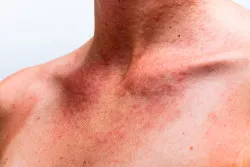 Thanks to its convenience and ease of use, azithromycin has become one of the most popular antibiotics in the U.S.
Thanks to its convenience and ease of use, azithromycin has become one of the most popular antibiotics in the U.S.
In 2012 azithromycin, sold under the brand name Zithromax, accounted for $435 million in sales, even with competition from generic versions.
Azithromycin can be used in conveniently short courses. It’s sometimes marketed in three-day and five-day supplies known as a Z-Pak. Certain conditions can be treated with a single “megadose” of azithromycin.
Even though it’s popular, azithromycin is not without its side effects. In less common cases, these side effects can include severe skin reactions to azithromycin, such as Stevens Johnson Syndrome.
The Mayo Clinic’s website says that skin reactions to azithromycin can include excessively dry skin that may become scaly or cracked. Patients’ skin may also develop “[b]listering, crusting, irritation, itching, or reddening.”
In rare cases, the patient’s skin may blister, peel or come loose. These symptoms may be signs of Stevens Johnson Syndrome, a potentially life-threatening drug reaction.
Due to the severity of SJS, the Mayo Clinic recommends that patients stop taking azithromycin and consult their doctor immediately if they experience “blistering, peeling, or loosening of the skin; red skin lesions; severe acne or skin rash; sores or ulcers on the skin; or fever or chills” while using the drug.
Case Study of Azithromycin SJS
One case study published in 2006 describes the effects of SJS in a 62-year-old woman. She had been taking azithromycin for an upper respiratory tract infection. When she was admitted to the hospital ten days later, her skin reactions to azithromycin included “toxo-allergic dermatitis and collagenosis.”
After a few days of treatment, some symptoms had improved – but she had also developed a rash over the palms of her hands and later over her feet. It took several days of treatment with corticosteroids to clear up the rash and fever, and gradually her skin lesions disappeared.
Other Symptoms of Severe Skin Reactions to Azithromycin
The subject in that study managed to avoid some of the more serious symptoms of SJS. While she did experience the rash that is one trademark symptom, in other patients blisters tend to form within those areas of rash.
With SJS, these blisters may grow into entire areas of skin that slough off, exposing the lower layer of skin beneath. Loss of the outer layer of skin creates a risk of developing a life-threatening infection.
Mucous membranes also develop painful lesions, though without forming actual blisters. Affected surfaces can include the conjunctiva, the layer of tissue that connects the white of the eye to the eyelid. Eyes may become red, crusted, sticky, and sensitive to light. In rarer cases, corneal damage may put the patient at risk for permanent blindness.
For patients who expected nothing more than to take a short course of azithromycin and be done with it, SJS can be an immensely disrupting complication.
Both the condition itself and the hospitalization required to treat it can disrupt the patient’s life for days or weeks, causing them to miss work while racking up medical expenses at the same time.
If you or someone you love suffered SJS or another skin reaction while taking azithromycin, you may be able to pursue legal recourse.
Do YOU have a legal claim? Fill out the form on this page now for a free, immediate, and confidential case evaluation. The Stevens Johnson Syndrome attorneys who work with Top Class Actions will contact you if you qualify to let you know if an individual lawsuit or class action lawsuit is best for you. [In general, SJS lawsuits are filed individually by each plaintiff and are not class actions.] Hurry — statutes of limitations may apply.
ATTORNEY ADVERTISING
Top Class Actions is a Proud Member of the American Bar Association
LEGAL INFORMATION IS NOT LEGAL ADVICE
Top Class Actions Legal Statement
©2008 – 2025 Top Class Actions® LLC
Various Trademarks held by their respective owners
This website is not intended for viewing or usage by European Union citizens.
Get Help – It’s Free
Help for Victims of Stevens Johnson Syndrome
If you or a loved one were diagnosed with Stevens Johnson Syndrome (SJS) or toxic epidermal necrolysis (TEN) after taking a prescribed or over-the-counter medication, you may be eligible to take legal action against the drug’s manufacturer. Filing an SJS lawsuit or class action lawsuit may help you obtain compensation for medical bills, pain and suffering, and other damages. Obtain a free and confidential review of your case by filling out the form below.
An attorney will contact you if you qualify to discuss the details of your potential case at no charge to you.
Please Note: If you want to participate in this investigation, it is imperative that you reply to the law firm if they call or email you. Failing to do so may result in you not getting signed up as a client, if you qualify, or getting you dropped as a client.
Oops! We could not locate your form.












